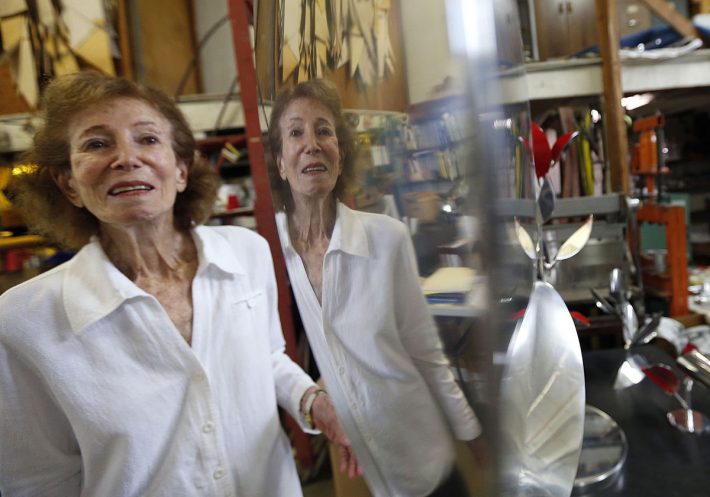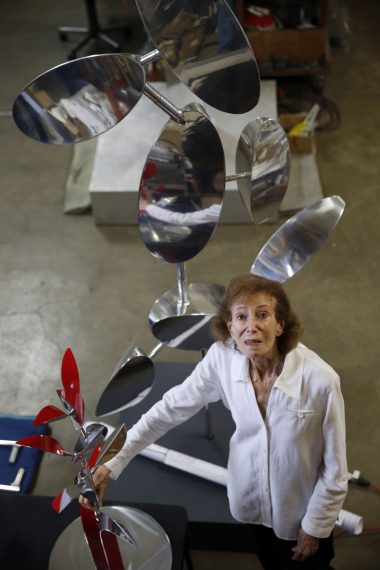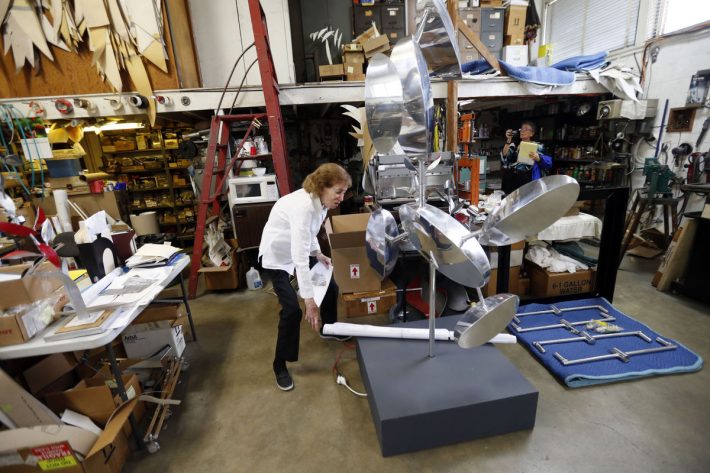by Janet McConnaughey | The Associated Press, via nola.com

ASSOCIATED PRESS | Sculptor Lin Emery is reflected on one of her sculptures in her studio in New Orleans. Her kinetic sculptures, moved by magnets, water, or wind are in museum and private collections around the U.S., in Europe and the Far East.
NEW ORLEANS (AP) — New Orleans sculptor Lin Emery’s career began on a whim as feather-light as the movement of the dancing metal sculptures that can be seen across the world. At 23, she wandered into a famous sculptor’s Paris studio and asked about lessons. He took her on as a demonstration to show his more advanced students how to teach total neophytes.
Emery, 90, loved sculpture from the first touch of clay. She grew up at a time when left-handedness was seen as something to correct, and said a big reason she loved sculpture was that she had free rein to use both hands.
“I had been born left-handed and had been whipped out of using the left hand. Clay was the first time I could use my left hand for everything,” said Emery, standing in her New Orleans studio. Around her are photographs, books, notebooks, power tools — and art, lots of art.
The art includes paper and aluminum preliminary models for a sculpture. Though its enameled accents are red and there’s not a hint of green, the sculpture’s two tall blades and the curved shapes rising above them remind a viewer of tall grass. There are smaller pieces Emery’s working on just for herself, such as an abstract figure of the Egyptian goddess Isis.

ASSOCIATED PRESS | Sculptor Lin Emery poses in her studio in New Orleans.
Nearly seven decades after Emery first put hands to clay she’s still creating new artwork for clients such as hospitals in New Orleans and Kansas, a New Orleans personal injury lawyer and the city of Birmingham, Alabama.
She still gleefully welcomes new commissions. When she reads for enjoyment it’s in French, to keep the language fresh in her mind. And according to her son, Brooks Braselman, the only time she relaxes is when she’s reading in bed.
“I’ve never seen her just sit on a sofa or a chair,” he said.
Emery’s life has always been in motion. She shuttled between Florida and New York as a girl and, starting at age 15, enrolled in universities in New York, Mexico and Illinois but never graduated.
Her first experience of New Orleans was a visit to her governess in 1943, to get away from the cold winter of Syracuse, N.Y. She settled there 10 years later, drawn by the city’s laissez-faire attitude.
She applied to take welding at the local community college in 1950, but was rejected: it had no women’s restrooms, officials said. Instead she spent the next two years at The Sculpture Center in New York, where she learned to weld and cast metal.
Back in New Orleans, an architect saw her 1952 abstract “Archangel Michael” — a 3-foot-tall composition of rounded angles suggesting wings — and commissioned her to make a more realistic piece for a church he was designing. That led to more church commissions.
Her work is dotted across the Crescent City and its suburbs. There are angels, pietas and stations of the cross at churches, and abstract birds in flight on the front of the Jewish Community Center. “Wave,” created in 1985 for the reflecting pool in front of the New Orleans Museum of Art, is now in its sculpture garden.
As she progressed in her career she became known for her kinetic sculptures — these days, delicately balanced forms which dance to the lightest breeze.
A kitchen chore, washing dishes in 1954, sparked the first moving sculptures, which she called aquamobiles.
“A spoon was caught on the side of a cup, and the water dripped into it and it swung back and forth,” Emery said. That sparked study so she could design water-propelled creations. “Water can do many things — it can spin, it can drop, it can push,” she said.
But water also has problems. Pumps break. Freezing weather stops the flow. Emery moved to magnets on motorized turntables.
“Eventually I found that air was easier to deal with and more reliable,” she said.
Looking back on her career she doesn’t pause to think about whether there is a piece, a commission, an honor of which she’s particularly proud.
“Not really. I’m always hoping to do better,” she said.

Sculptor Lin Emery turns off the power to one of her indoor kinetic sculptures in her studio.
